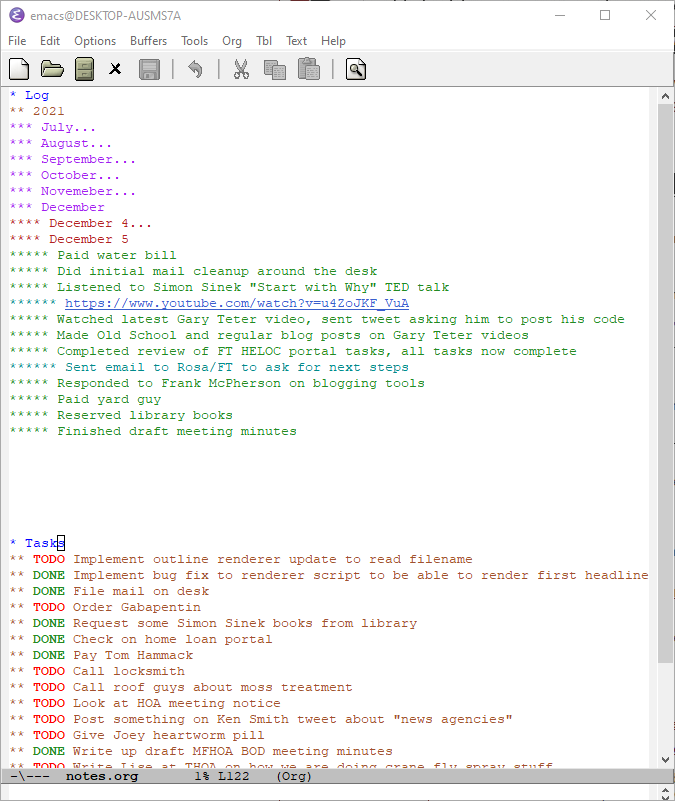I have been using the Org Mode feature within Emacs for two years now, primarily for keeping a work log and a work to-do list (wrote about this in December 2021). The outlining features and the TODO/DONE construct have been sufficient for me to do what I needed to do. I have not spent much time learning other features, mostly because of my resistance problem. However, I have decided to try to use Org Mode to manage/organize my personal bookmark library. This is spread across multiple text and word processing documents, and I want to be able to search them and for this collection to not be a “write-only” set of data (which is mostly what it is).
When I started researching how I might go about this effort, I found a lot of examples of Org Mode capture templates, Elisp programs, and other techniques. This was a little overwhelming, so I decided to step back and think about my requirements – what data did I want to save, and what did I want to do with these bookmarks (see Karl Voit for reference). These were my initial “data requirements”:
1. Link URL and title of page
2. Tags
3. Description of URL content/other comments
4. Date/timestamp
My main “what to do” requirements were:
1. Search (by tags, text string, something else)
2. Present by some organization (like tags)
I spent time learning about capture templates, and the various features of those templates, and again felt overwhelmed. I decided then to just try capturing the data items above just in a word processing document. After doing that for my five most recent bookmarks, I still felt like that was the right data to collect. I then tried to think about the simplest way to collect that data using the org-capture feature.
After reviewing all the examples I had collected, I decided to try a capture template that provided a way to enter the same data I had entered in my word processing document. I went with a template from Karl Voit’s post on bookmarks and Org:
("b" "Bookmark" entry (file+headline "~/share/all/org-mode/notes.org" "Bookmarks")
"* %?\n:PROPERTIES:\n:CREATED: %U\n:END:\n\n" :empty-lines 1)
I added this to some capture templates I had already created in my .emacs file.
'(("l" "Link" entry (file+headline "C:/Users/sylve/Documents/OrgFiles/GTD/links.org" "Links")
"* %? %^L %^g \n%T" :prepend t)
("n" "Note" entry (file+headline "C:/Users/sylve/Documents/OrgFiles/GTD/newnotes.org" "Notes")"* %u %? " :prepend t)("b" "Bookmark" entry (file+headline "C:/Users/sylve/Documents/OrgFiles/GTD/linkskv.org" "Bookmarks")"* %?\n:PROPERTIES:\n:CREATED: %U\n:END:\n\n" :empty-lines 1)I had also learned about how Org Mode can render a bookmark as a live link if entered in this form:
[[URL][Link text]]
I decided to enter the URL and title in this way. When an entry was complete, it became a link that could be clicked on and open a new browser tab with that URL. After trying the new capture template, I felt that would serve for now.
* Bookmarks
** [[http://www.howardism.org/Technical/Emacs/capturing-content.html][Capturing Content for Emacs]]
:PROPERTIES:
:CREATED: [2022-07-24 Sun 17:51]
:END:
More examples of how to capture content in other apps and get it into Emacs
org_mode, org_capture
Next post: a summary of the Org Mode bookmark tools/techniques I found in my initial search.
